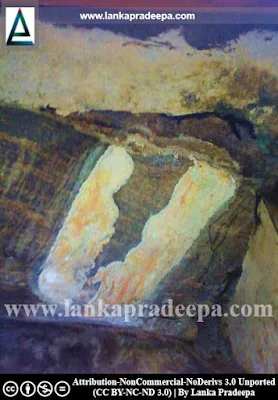
Gonagolla Viharaya, also known as Gonagolla Punchi Sigiriya (Sinhala: අම්පාර ගොනාගොල්ල විහාරය), is an ancient Buddhist temple located in Kothmale colony village in Ampara District, Sri Lanka. The site can be reached by travelling along the Senagama-Gonagolla road about 5 km distance from Weranketagoda town.
History
The history of Gonagolla Viharaya is dated to the Anuradhapura Period. Several inscriptions and a rock painting that is believed to belong to the 5th century A.D. have been found on the site (Sirimalwatta, 2016).
Inscriptions
Five epigraphs, all rock inscriptions belonging to the 3rd-5th centuries A.D. are identified at the site (Sirimalwatta, 2016). They all have been inscribed on a rock plane on which an ancient flight of steps and the remains of an ancient structure are found.

Gonagolla rock inscriptions
(Ref.: The information board at the site by the Director-General of Archaeology)
Period: 3-4th centuries A.D.
Scripts: Later Brahmi
Language: Old Sinhala
# First inscription
Content: About a donation made by the wife of district governor Mahinda and the wife of district governor Bakadaya to a Vihara
# Second inscriptionContent: A donation of robes for the monks of the Alithaka Maha Viharaya for the rainy season by a person name Abaya of Maharata | # Third inscriptionContent: A donation of Kahavanu (money) by a person to the Alithaka Maha Viharaya for the maintenance of the Ariyavansa ceremony |

Period: 4-5th centuries A.D.
Scripts: Transitional Brahmi
Language: Old Sinhala
# First inscription
Content: A donation made to the community of monks of a monastery.
# Second inscription
Content: It records a flight of steps constructed by Nadasaba of Gotigama. The merit thus acquired is offered to all beings.
An Old Painting Fragment
A fragment of an old painting found in a cave at Gonagolla temple was recorded in 1956, by the then Commissioner of Archaeology (acting), P. E. P. Deraniyagala (Sirimalwatta, 2016; Wijesekara, 1990).

This fragment contains two figures, a female dancer and a man (Charles, 1998; Wijesekara, 1990). They are drawn on a white background and coloured with red, yellow, and green colours. The female figure is exquisitely executed in an attitude of reverence or supplication towards the male figure. The male figure is apparently holding a lotus stalk and has been painted with a halo around his head (Sirimalwatta, 2016). Prominent archaeologist Senarath Paranavithana thinks that this fragment of painting belongs to a time between the Sigiriya and the Polonnaruwa Periods (Somathilake, 2000; Wijesekara, 1990). According to him, this painting depicts an act of expecting rain (Charles, 1998; Sirimalwatta, 2016; Withanachchi, 2013).
Senaka Bandaranayake in his book "The Rock and Wall Paintings of Sri Lanka" says that the style of Gonagolla painting is closely related to the paintings found in Vessagiriya and Sigiriya (Bandaranayake & Jayasinghe, 1986). He dates this painting to a period ranging from the 5th century to the 7th century A.D. (Somathilake, 2000). Depending on the rock inscriptions found in situ, D. B. Dhanapala has dated this painting to the 3rd century A.D. (Somathilake, 2000; Wijesekara, 1990).
S. P. Charles believes that this painting is older than the Polonnaruwa Period (Charles, 1998). According to him, there are some similarities between this painting and the paintings found at Pulligoda and Thivanka Pilimage in the Polonnaruwa Ancient City (Charles, 1998).
A Protected Site
Rock with the paintings of Adiwasi people (indigenous people) and Anuradhapura era, all drip-ledged caves, the hillock of Dagoba buildings with stone pillars, places of ruins, rock inscriptions and flights of steps and buildings, and the rock with two ponds and base stones situated in Gonagolla cave temple (Punchi Seegiriya) in Kothmale colony village situated in the Grama Niladhari Division No. W/104A/01/050, Kothmale in the Divisional Secretary’s Division Uhana are archaeological protected monuments, declared by a government gazette notification published on 10 October 2014.


References
1) Bandaranayake, S. Jayasinghe, G., 1986. The Rock and Wall Painting of Sri Lanka. Lake House Bookshop. p.35.
2) Charles, S.P., 1998. (Editor: Nahiya, A.M.). Gal-Oya Gonagolla bithu sithuwam (In Sinhala). North-East Sri Lanka; A compendium; 50th Anniversary of Sri Lanka's Independence 1948-1998. North-East Provincial Council, Trincomalee. pp.523-524.
3) Sirimalwatta, 2016. Perani sithuwam kalawe agana nimewumak vu Gonagolla (In Sinhala). Dayada Newsletter. July 2016. 10th edition. Department of Archaeology. p.12.
4) Somathilake, M., 2000. A historical study of Buddhist mural paintings of peninsular India and Sri Lanka during the ancient period (from second century BC to twelfth century AD). A thesis submitted to the Jawaharlal Nehru University in fulfilment of the requirement for the award of the degree of Doctor of Philosophy. pp.183-184.
5) The Gazette of the Democratic Socialist Republic of Sri Lanka. No: 1884. 10 October 2014. p.922.
6) Wijesekara, N. (Editor in Chief), 1990. Archaeological Department
Centenary (1890-1990): Commemorative Series: Volume V: Painting.
pp.32-33.
7) Withanachchi, C.R., 2013. Pauranika Sthana Ha Smaraka: Ampara Distrikkaya (In Sinhala). Department of Archaeology. ISBN: 955-9159-44-5. pp.33-34.

